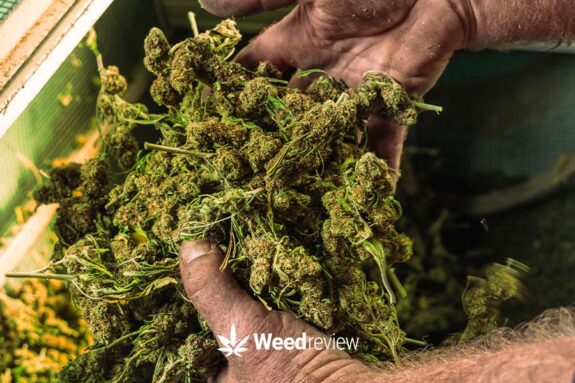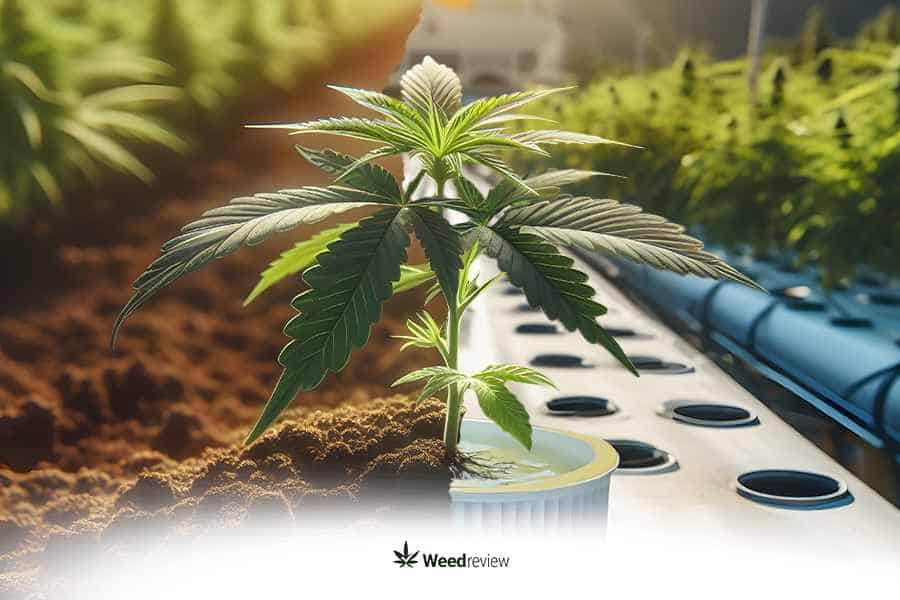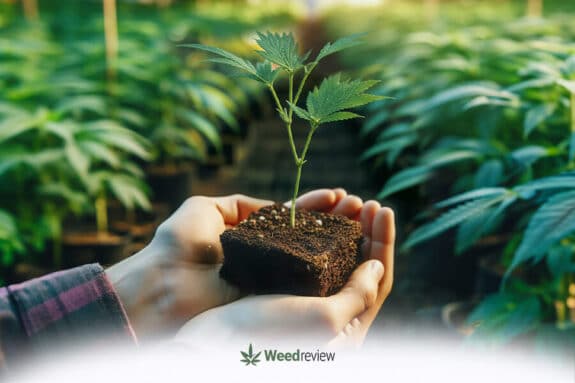
Hydroponic vs Soil Cultivation: What Should You Use for Growing Cannabis?

Table of Contents
Hydroponics and soil cultivation are two popular methods of growing marijuana. Each comes with unique benefits and disadvantages.
Hydro weed grows faster, larger, and is highly scalable – however, it requires experience and investment. Marijuana grown in soil is more organic, natural, and cheap to grow – but it grows slowly.
In this article, we’ll provide a deep comparison, looking at attributes like costs, yields, space, and potency, to help gauge whether hydro or soil is ideal for your requirements.
What is hydroponics?
Hydroponics is a soil-less way of growing cannabis. Instead, the plants are grown in water, where the nutrients directly feed the plant’s roots. This method of growing is popular because of its benefits, mainly the explosive growth of your weed plants.
Pros
- High yields, fast growth: Hydroponics lead to faster harvests and greater yields than traditional soil methods. This is because of the increased nutrient availability, which allows your weed to focus more energy on buds rather than looking for nutrients in the soil.
- Space and water efficiency: Hydroponic systems can be designed to fit any space, large or small, which makes them a great option for indoor growing. Additionally, hydroponics is water-efficient, as the system reuses water, reducing usage.
- Excellent for commercial use: Large-scale farmers and industrial producers generally rely on hydroponics for its ability to produce multiple harvests in a season.
Cons
- Initial cost and complexity: Setting up a hydroponic system can be complicated and expensive. The system requires equipment like grow lights, water pumps, and nutrient solutions, which can be expensive.
- Risk of system failure: In hydroponics, plants rely on water pumps and lights for survival. Any failure in the system, such as a power outage or pump failure, could damage or even kill the plants in a short time.
What is soil growing?
Soil growing is the most traditional method of cultivating cannabis, using the earth as a natural medium for the plant’s roots. This method is popular among beginners for its ease of use and lower costs for growing.
Pros
- Natural nutrients: Soil naturally contains many of the nutrients cannabis plants need to grow. It acts as a buffer for the roots, storing nutrients and water that the plant can access as needed.
- Ease of use: Soil growing is more forgiving than hydroponics. Minor mistakes with pH, temperature, and nutrients don’t have the instant negative effects they can have in a hydroponic system.
Cons
- Water and nutrient management: Soil-based growing requires careful watering and nutrient management to prevent issues like overwatering, nutrient burn, or deficiencies.
- Pests and Disease: Soil can harbour pests and diseases that can harm your cannabis plants. You must care for the plants and maintain them well to keep these issues at bay.
Differences and similarities between hydroponics and soil growing
Hydroponics and soil differ regarding things like growing medium, costs, and experience. However, they do share similarities in terms of common problems a cannabis plant can incur – no matter where it is grown.
Why are they different?

Grow medium
The primary difference between hydroponics and soil growing lies in the growth medium.
Soil, being a natural medium, is rich in organic matter like compost and manure, offering a diverse range of nutrients and microorganisms. In contrast, hydroponic systems rely on a water-based solution enriched with specific nutrients, providing a controlled and direct feeding environment for the plants.
Germination & transplanting
Both methods might begin with similar seed germination techniques like the glass of water or kitchen towel methods.
- After germination, soil growers can plant the seeds directly into their final spot, or they can be started in smaller containers or soil plugs and then transplanted. This process is generally easy, involving moving the young plant into a larger soil environment.
- In contrast, hydroponic growers usually use special materials like Rockwool cubes or starter plugs, which are better suited for hydroponic systems. This involves carefully placing them in net pots that hold the plants while allowing roots to access nutrient-rich water.
Costs & experience
- Hydroponics requires constant monitoring, adjustments, and a high starting capital. As such, experience is a requirement when working with hydro cannabis.
- Soil is easier for beginners. It is affordable and gives a window of opportunity to fix any problems thanks to the buffer the soil provides. That said, using soil requires careful watering management to keep the right moisture level in the soil.
How are they similar?
Despite the differences between hydroponic and soil cultivation, common issues within the cannabis plant’s growth cycle can appear using either method.
For instance, nutrient deficiencies often present themselves in hydroponics and soil growth. Regardless of the medium, the yellowing and wilting of leaves could indicate a lack of Nitrogen or Potassium.
Even though less likely in hydroponics, pests can also invade both systems. Spider mites, for example, are a common pest that can infest cannabis plants in either setup.
Hydroponics vs. soil for growing marijuana: Which is better?
There are many factors that will help you decide which system works best for you. Here is a breakdown of how each element of cannabis growth is affected by either hydro or soil growing.
| Hydroponics | Soil | |
|---|---|---|
| Costs | Expensive upfront, cheaper over time | Cheaper upfront, expensive over time |
| Yields | Can potentially yield more with a controlled environment | May yield less but can offer a more developed terpene profile |
| Space | Can fit more in a smaller space due to vertical farming | Traditionally requires a dedicated space that spreads outward and not up |
| Pest management | Harder to balance pH, but problems take longer to develop | Can be prone to infestation, especially from soil-borne fungus gnats |
| pH level management | Generally easier to keep the pH balanced but requires consistent checking | Harder to balance pH but problems take longer to develop |
| Nutrient management | Precise dosing saves money and helps grow large plants | Requires adding nutrients to the soil and can be affected by microorganisms present in the medium |
| Potency | The tightly controlled environment can optimise the potency of even low-THC strains | Environmental factors such as weather or pests can lower the potency |
| Speed & time | Accelerated plant growth thanks to the direct contact with the nutrient solution | Plants can be stunted due to overwatering or other environmental issues |
| Weeding | No seeds can germinate so no harmful weeds will grow | Various weeds and other plants can grow in the same soil as the cannabis |
| Water consumption | Highly water-efficient: water is cycled through the system | Loses water through absorption and from the bottom of the container |
| Flexibility | Allows growing multiple harvests a year since it is indoor | Harder to balance pH, but problems take longer to develop |
Costs
When determining the most suitable method to grow cannabis, it’s important to consider your budget.
- Startup costs: With hydroponics, the initial setup costs are higher as the system is more complex, but it’s an investment you can use for multiple grows. In contrast, soil requires a built-out area or pots, which could be less expensive upfront but may not be reusable.
- Ongoing costs: Hydroponics uses more electricity than soil growing because of the addition of pumps and timers. Soil cultivation, however, involves purchasing amendments and support systems such as trellis, nutrients, planting pots, etc.
To sum up, if you can invest upfront and commit to maintaining a hydroponic system, it may offer better long-term value. Otherwise, soil growing is a more cost-effective start.
Yields
When comparing yields, hydroponics generally leads the race. Hydroponic systems can produce up to 20-30% larger yields than traditional soil methods, thanks to a controlled environment and efficient nutrient delivery.
Soil cultivation, on the other hand, might yield less but can offer a unique aroma and flavour profile to the cannabis. This method allows for better terpene development thanks to the soil’s microbiome.
Indoor or outdoor
Hydroponic is best recommended for indoor growing, while with soil, you can grow your plants inside or outside. Of course, if you are growing them outdoors, care must be taken to protect them from weather and pest conditions.
Space
Hydroponic systems allow you to use space optimally by stacking plants vertically. This allows for greater plant density within a smaller footprint.
Soil cultivation typically needs a larger horizontal area, for example, an outdoor land plot. While both methods have their merits, vertical hydroponic systems are better with limited space.
Pest management
Pest management is another area where hydroponics shines. With hydroponics, the risk of pest infestations is significantly reduced. It eliminates soil-borne pests like fungus gnats, a common problem in soil growing.
The controlled environment effectively deters pests, making hydroponics a clear winner in terms of pest management.
pH level management
The process of managing pH levels is easier in hydroponic systems. With this method, you can make quick and precise adjustments to pH levels to suit the plants’ specific needs.
In soil cultivation, however, the pH can fluctuate depending on the presence of organic matter in the soil, moisture levels, and even temperature. Hydroponics makes it easier to test and fix pH levels, but a slight difference in pH is less likely to cause issues in soil growing than in hydro systems.
Nutrient management
In hydroponics, nutrient management is streamlined and precise, as nutrients are delivered directly to the plant’s roots in a water-based solution. Soil cultivation, meanwhile, involves a more complex nutrient management process.
Nutrient delivery depends on the soil quality and composition. Uptake can be affected by various factors, such as soil pH and water retention. Thus, hydroponics makes nutrient management easier, especially for beginners.
Potency
The potency of weed grown in hydroponic systems and soil can vary significantly, and a definitive winner is hard to establish.
However, hydroponics has the benefit of optimised growth conditions. They give you more chances to influence potency. Yet, it also depends on the specific strain attributes and your plant’s quality of life.
Speed & time
When considering speed and time, hydroponics outpaces soil cultivation. Plants grow faster in hydroponic systems as nutrients are directly accessible, accelerating growth rates by up to 50%.
Soil-grown plants, conversely, take longer due to slower nutrient absorption. For growers seeking quick yields, hydroponics is better. The faster turnaround in hydro systems also allows beginners to learn and adapt their growing techniques quickly.
Weeding
Weeding is virtually non-existent in hydroponics as the system is closed off, preventing unwanted seeds from infiltrating. Soil cultivation can be more labour-intensive, requiring regular weeding to maintain plant health and maximize yields. Thus, hydroponics is better for those who don’t have a lot of time.
Water consumption
Although hydroponic systems rely on water as a primary medium, they are surprisingly more water-efficient than soil-based cultivation. The water in hydroponic systems is recirculated, which minimises waste.
Growing cannabis in soil involves a lot of watering, and much of this water is lost due to absorption and evaporation. In this case, hydroponics offers a better solution in terms of water consumption.
Flexibility
Hydroponics allows you to grow weed all year round since it is inside in controlled conditions. Still, these systems can break or malfunction and are sensitive to any issues with electricity.
Growing inside using soil will also be a good solution for multiple harvests yearly. However, if you are growing outside using soil, then you are at the mercy of Mother Nature and limited to one harvest a season.
Conclusion
Forr those seeking efficiency, water conservation, and reduced maintenance, hydroponics is the clear winner. Hydro is also recommended for commercial operations. But do note that going down this path requires high initial capital and experience.
Soil cultivation is perfect for those who cannot afford to invest in a complex hydroponic system. It is a simple, traditional approach that does not require technical knowledge. Instead, you must invest time and effort to get large harvests.
FAQ
-
Which is easy: hydroponic or soil?
Soil cultivation is easier and more forgiving for beginners. It requires minimal technical knowledge and is more tolerant of mistakes. Hydroponics has a steeper learning curve and requires more precise management of factors like pH and nutrient levels.
-
Is hydro weed more potent than soil-grown cannabis?
No, it is not always true that hydroponic cannabis is more potent. The potency and THC levels depend on the strain, nutrient levels, and environment.
-
Which is faster: hydroponic or soil?
Hydroponic cannabis grows much faster than its soil counterparts. This allows for multiple harvests in a year.
-
Which is better for cannabis: hydro or soil?
Hydroponics allow for precise control over your growing environment, leading to faster growth and higher yields. Soil, being a traditional approach, takes time but can produce yields with a more natural aroma and flavour.
-
Which produces large yields: soil or hydroponics?
Hydroponics, on average, produces 20-30% greater yields than soil. The size of the flowers may be larger too.
-
What nutrients are needed for hydroponic and soil cannabis?
Both hydroponic and soil require the same nutrients, but the delivery method differs. In soil, nutrients are added and absorbed through diffusion from organic or synthetic sources, while in hydroponics, nutrients are directly added to the water.


